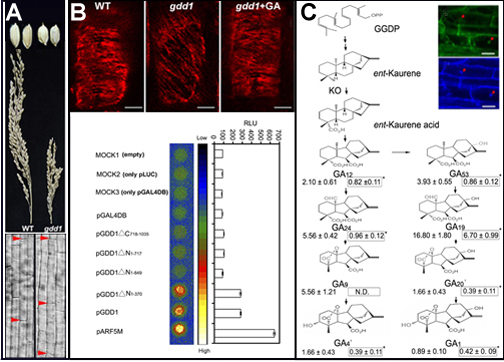Motor protein is a kind of protein which transfers chemical energy into mechanical energy depending on the cytoskeleton. It’s essential in animal and plant cell growth and cell division. In addition to providing energy, however, other physiologic functions of the protein in animal and plant cells are still remain unknown. Research group lead by Professor CHONG Kang from Institute of Botany, CAS, and his collaborators identified and confirmed the type of a kinesin motor protein with transcription factor activity, and the mutation of the protein leads to decrease of gibberellin (GA) synthesis level and block of cell elongation.
Researchers describe a rice (Oryza sativa) mutant, gibberellin-deficient dwarf1 (gdd1), that has a phenotype of greatly reduced length of root, stems, spikes, and seeds. This reduced length is due to decreased cell elongation and can be rescued by exogenous gibberellic acid (GA3) treatment. GDD1 was cloned by a map-based approach, was expressed constitutively, and was found to encode the kinesin-like protein BRITTLE CULM12 (BC12). Microtubule cosedimentation assays revealed that BC12/GDD1 bound to microtubules in an ATP-dependent manner. Whole-genome microarray analysis revealed the expression of ent-kaurene oxidase (KO2), which encodes an enzyme involved in GA biosynthesis, was downregulated in gdd1. Electrophoretic mobility shift and chromatin immunoprecipitation assays revealed that GDD1 bound to the element ACCAACTTGAA in the KO2 promoter. In addition, GDD1 was shown to have transactivation activity. The level of endogenous GAs was reduced in gdd1, and the reorganization of cortical microtubules was altered. Therefore, BC12/GDD1, a kinesin-like protein with transcription regulation activity, mediates cell elongation by regulating the GA biosynthesis pathway in rice.
The research work was recently published online on the Plant Cell (http://www.plantcell.org/content/early/2011/02/15/tpc.110.081901.full.pdf+html). The study was supported by NNSFC projects and 863 projects.

Fig. GDD1 mutation induces cell growth, KO2 gene expression and block of gibberellin (GA) metabolism.
A. Seed and ear of mutants and blocked cell growth. B. GA restored mutant microtubule arrangement, GDD1 has transcriptional activation activity. C. GDD 1 Location and GA metabolism in mutants.
Motor protein is a kind of protein which transfers chemical energy into mechanical energy depending on the cytoskeleton. It’s essential in animal and plant cell growth and cell division. In addition to providing energy, however, other physiologic functions of the protein in animal and plant cells are still remain unknown. Research group lead by Professor CHONG Kang from Institute of Botany, CAS, and his collaborators identified and confirmed the type of a kinesin motor protein with transcription factor activity, and the mutation of the protein leads to decrease of gibberellin (GA) synthesis level and block of cell elongation.
Researchers describe a rice (Oryza sativa) mutant, gibberellin-deficient dwarf1 (gdd1), that has a phenotype of greatly reduced length of root, stems, spikes, and seeds. This reduced length is due to decreased cell elongation and can be rescued by exogenous gibberellic acid (GA3) treatment. GDD1 was cloned by a map-based approach, was expressed constitutively, and was found to encode the kinesin-like protein BRITTLE CULM12 (BC12). Microtubule cosedimentation assays revealed that BC12/GDD1 bound to microtubules in an ATP-dependent manner. Whole-genome microarray analysis revealed the expression of ent-kaurene oxidase (KO2), which encodes an enzyme involved in GA biosynthesis, was downregulated in gdd1. Electrophoretic mobility shift and chromatin immunoprecipitation assays revealed that GDD1 bound to the element ACCAACTTGAA in the KO2 promoter. In addition, GDD1 was shown to have transactivation activity. The level of endogenous GAs was reduced in gdd1, and the reorganization of cortical microtubules was altered. Therefore, BC12/GDD1, a kinesin-like protein with transcription regulation activity, mediates cell elongation by regulating the GA biosynthesis pathway in rice.
The research work was recently published online on the Plant Cell (http://www.plantcell.org/content/early/2011/02/15/tpc.110.081901.full.pdf+html). The study was supported by NNSFC projects and 863 projects.
 |
|
Fig. GDD1 mutation induces cell growth, KO2 gene expression and block of gibberellin (GA) metabolism. A. Seed and ear of mutants and blocked cell growth. B. GA restored mutant microtubule arrangement, GDD1 has transcriptional activation activity. C. GDD 1 Location and GA metabolism in mutants. |
